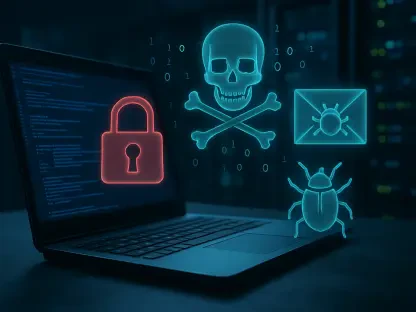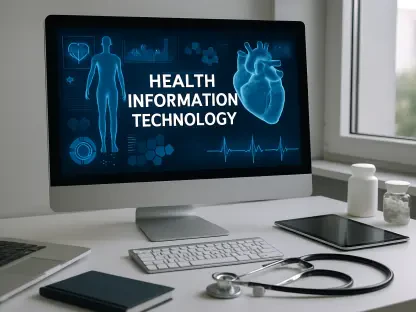Operational Technology (OT) systems have evolved significantly from isolated setups to interconnected networks that demand advanced security measures. As OT infrastructures increasingly integrate with Information Technology (IT) systems, businesses must adopt robust security strategies to safeguard against emerging cyber threats. Exploring the significance of Zero Trust models and Privileged Access Management (PAM) in securing OT environments reveals critical insights into protecting critical infrastructure.
Understanding the Evolution of OT Security
From Isolation to Integration
Historically, OT systems operated in secluded environments, characterized by limited external connectivity that naturally minimized exposure to cyber threats. These isolated setups primarily focused on ensuring reliability and uninterrupted service, thereby providing a false sense of security due to the reduced attack surface. However, the relentless pursuit of efficiency, automation, and real-time monitoring has led to a profound transformation in OT systems, resulting in increased integration with IT networks. This integration has introduced new vulnerabilities and necessitated a comprehensive reevaluation of security postures across organizations.
The convergence of OT and IT has exposed operational systems to cyber threats that were previously associated mainly with IT environments. Modern industrial operations demand seamless data flow between OT and IT systems for enhanced decision-making and operational monitoring. Although this integration facilitates significant operational benefits, such as predictive maintenance and optimized resource management, it simultaneously presents cybercriminals with broader attack surfaces. Consequently, organizations must address this heightened vulnerability through advanced security frameworks, implementing measures to safeguard both IT and OT environments effectively.
The Challenge of Legacy Systems
Many OT environments continue to rely on legacy systems, including Industrial Control Systems (ICS) and Programmable Logic Controllers (PLCs). These systems, designed for durability, functionality, and prolonged operational lifespans, inherently lack modern cybersecurity considerations. Furthermore, they often utilize proprietary protocols and outdated architectures that challenge the implementation of current security measures. The complexity of retrofitting cybersecurity mechanisms into these legacy systems cannot be overstated, placing OT environments at a heightened risk of cyberattacks.
Securing legacy OT systems requires a delicate balance between maintaining operational continuity and introducing advanced security measures. Proprietary technologies present unique challenges in terms of compatibility with contemporary security solutions. Consequently, organizations must adopt tailored strategies to address these vulnerabilities effectively. Network segmentation, endpoint security, and the gradual introduction of newer technologies are among the approaches that can help mitigate the risks associated with legacy systems, ensuring that operational technology remains secure while continuing to deliver essential services uninterrupted.
Bridging OT and IT
Increasing Complexity of Interconnectivity
The increasing need for real-time data, remote monitoring, and effective operation management has blurred the traditional separation between OT and IT networks. This technological convergence offers substantial operational advantages, enabling enhanced data analytics, production efficiency, and regulatory compliance. However, it also introduces new attack vectors that cybercriminals can exploit, highlighting the necessity for sophisticated security protocols to keep up with evolving threats. The connection between OT and IT systems is no longer a mere integration but a vital component of modern industrial processes.
The complexity of interconnected networks demands a thorough understanding of the potential security implications. Modern OT environments encompass numerous devices, sensors, and control elements that need seamless communication with IT systems. This level of integration requires meticulous security measures to protect sensitive data and secure critical infrastructure against unauthorized access. Robust protocols and monitoring systems can help detect anomalies and prevent attacks, ensuring a secure and resilient operational environment amid increased interconnectivity.
The Role of Robust PAM Practices
Effective Privileged Access Management (PAM) is crucial in mitigating risks associated with interconnected OT and IT environments. Without proper PAM, cyber attackers can exploit excessive privileges or compromised credentials to infiltrate interconnected systems, potentially leading to devastating consequences such as ransomware, malware, and severe data breaches. PAM strategies offer essential protection by controlling and monitoring access to sensitive systems, ensuring that only authorized personnel can perform critical actions within the network.
Developing a comprehensive PAM framework involves implementing multi-factor authentication (MFA), role-based access control (RBAC), and just-in-time (JIT) access mechanisms. These practices help limit exposure to cyber threats by providing stringent identity verification and reducing the risk of unauthorized access. Regular auditing and monitoring of privileged access activities can detect suspicious behavior promptly, preventing lateral movement within the network and safeguarding critical infrastructure. Organizations that adopt robust PAM measures can significantly enhance their overall security posture, ensuring the integrity and resilience of interconnected OT and IT environments.
Addressing Inconsistencies in Security Standards
The Lack of Uniform Standards
Unlike IT security, OT security lacks universally applied standards, despite the existence of frameworks such as ISA/IEC 62443. Many organizations encounter significant challenges in consistently implementing these frameworks, leading to security gaps that leave OT environments vulnerable to exploitation. The disparity in security standards results from the unique operational requirements and diverse technologies employed in OT systems, necessitating customized security strategies that address specific risks effectively.
A harmonized approach to OT security involves aligning practices with recognized industry standards and ensuring consistent application across the organization. Adopting a structured defense strategy based on frameworks such as ISA/IEC 62443 provides a robust foundation for securing OT systems. Regular audits, security assessments, and adherence to best practices play vital roles in maintaining a resilient security posture. Addressing inconsistencies in security measures helps establish a comprehensive protective framework that mitigates risks and enhances the overall security of operational technology.
Moving Beyond Traditional Security Models
Traditional security practices like air-gapping, once considered the gold standard in OT security, are inadequate in modern industrial contexts that demand continuous connectivity. Functions such as predictive maintenance, supply chain integration, and remote access for field technicians necessitate an evolution in security postures. Air-gapped systems, isolated from external networks, do not accommodate the real-time data exchange and remote access required by contemporary industrial processes, compelling organizations to devise innovative security solutions that align with modern operational needs.
Implementing advanced security measures involves transitioning from isolated to integrated security models that accommodate continuous connectivity requirements. Encryption, secure communication protocols, and real-time monitoring are essential components of a modern security framework. Organizations must embrace proactive security strategies, incorporating assessment and monitoring tools that identify potential threats and address vulnerabilities before exploitation occurs. This transition to robust security models ensures that OT environments are protected against contemporary cyber threats, adapting to the dynamic landscape of modern industrial operations.
Enhancing OT Cybersecurity Awareness
The Gap in Cybersecurity Training
OT personnel, including engineers and operators, often prioritize operational uptime and efficiency over security considerations. This focus on maintaining uninterrupted service can lead to a lack of adequate training in recognizing and responding to cyber threats. Engineers and operators may not possess the necessary knowledge to identify potential vulnerabilities or implement effective security measures, undermining the overall effectiveness of advanced cybersecurity initiatives. Bridging this knowledge gap is essential to establishing a secure OT environment.
To address the cybersecurity training gap, organizations must prioritize consistent and comprehensive security education programs. These programs should encompass training on threat detection, response protocols, and the importance of cybersecurity in maintaining operational integrity. Empowering OT personnel with the knowledge to recognize cyber threats ensures that they can act promptly to mitigate risks, enhancing the overall security posture of the organization. Effective training programs support a culture of security awareness, integrating cybersecurity into daily operational practices and fostering a resilient OT environment.
Continuous Education and Training
Continuous education and training are crucial for maintaining a high level of cybersecurity awareness among OT staff. Implementing ongoing training initiatives helps ensure that personnel remain up-to-date with the latest threat landscapes, security protocols, and best practices. Regular workshops, simulations, and practical exercises enable OT staff to develop and sharpen their skills in identifying and responding to cyber threats, reinforcing the importance of cybersecurity in operational technology environments.
Organizations must establish a structured approach to continuous education, embedding cybersecurity training into the core practices of OT teams. This approach should involve collaboration between IT and OT departments, fostering a unified understanding of security objectives and practices. Investing in robust training programs promotes a proactive security culture, equipping OT personnel with the expertise to defend against evolving threats effectively. Continuous education and training help create an environment where cybersecurity is a fundamental consideration in all operational activities, enhancing the resilience of OT systems against cyberthreats.
Proactive Security Measures for OT
Implementing a Zero Trust Model
Adopting a Zero Trust approach in OT environments involves stringent identity verification processes and the assumption that no entity is inherently trusted. This model requires comprehensive Identity and Access Management (IAM) practices, including Multi-Factor Authentication (MFA), Role-Based Access Control (RBAC), and Just-in-Time (JIT) access, to limit exposure to potential threats. Zero Trust strategies ensure that all access requests are thoroughly vetted, preventing unauthorized entities from gaining access to critical systems.
Implementing a Zero Trust model involves creating an environment where security is embedded into every aspect of the operational infrastructure. Network segmentation, endpoint protection, and rigorous access control mechanisms are fundamental components of this approach. Continuous monitoring and regular security assessments help identify potential breaches and respond promptly, maintaining the integrity of the OT environment. By adopting a Zero Trust model, organizations can enhance their security posture, ensuring that critical systems remain protected against unauthorized access and cyber threats.
Securing Communication Channels and Real-Time Monitoring
Securing communication channels is pivotal in safeguarding OT environments against cyber threats. Implementing data encryption, secure communication protocols, and rigorous network traffic monitoring ensures that unauthorized activities are detected and addressed promptly. Despite challenges in updating and patching OT systems, strategies like network segmentation and endpoint protection can help mitigate risks effectively. Ensuring secure communication channels is essential to maintaining a robust defense against cyberattacks.
Real-time threat detection and response mechanisms are critical components of a proactive security strategy. Solutions such as Security Information and Event Management (SIEM) systems and AI-driven monitoring tools provide early warnings of potential threats, enabling prompt action to prevent breaches. Organizations must prioritize continuous monitoring practices to identify anomalies and address vulnerabilities swiftly. Securing communication channels and implementing real-time monitoring measures create a resilient OT environment, capable of defending against dynamic cyber threats.
Aligning with Recognized Frameworks and Continuous Improvement
Adopting Industry-Recognized Frameworks
Aligning OT security measures with established industry-recognized frameworks such as ISA/IEC 62443 ensures a structured and robust defense strategy. These frameworks provide comprehensive guidelines for securing OT systems, offering best practices that address specific vulnerabilities and risks. Implementing these frameworks consistently across the organization helps create a cohesive security posture, minimizing the likelihood of gaps that could be exploited by cybercriminals.
Regular security audits are an essential component of aligning with recognized frameworks. These audits help identify potential vulnerabilities before exploitation occurs, enabling organizations to address them proactively. Conducting thorough security assessments and adhering to industry standards ensure that OT environments remain resilient against evolving threats. By adopting recognized frameworks, organizations can enhance their overall security posture, creating a robust defense strategy that protects critical infrastructure effectively.
Emphasizing Proactive Security Integration
Operational Technology (OT) systems have undergone a substantial transformation from being standalone entities to becoming part of interconnected networks. This shift necessitates sophisticated security measures to protect these systems from increasing cyber threats. As OT infrastructure progressively converges with Information Technology (IT) systems, it becomes essential for businesses to implement comprehensive security strategies to defend against potential vulnerabilities. One crucial strategy includes the adoption of Zero Trust models, which assume no user or device is trustworthy by default, thereby enhancing security protocols. Another vital component is Privileged Access Management (PAM), which tightly controls access to critical systems and sensitive information, reducing the risk of insider threats or unauthorized access. Understanding the implications of these security frameworks and integrating them into OT environments is paramount for safeguarding critical infrastructure. These advanced security measures help ensure that businesses can protect their operational technologies effectively, thereby maintaining the integrity and reliability of essential services and operations.









